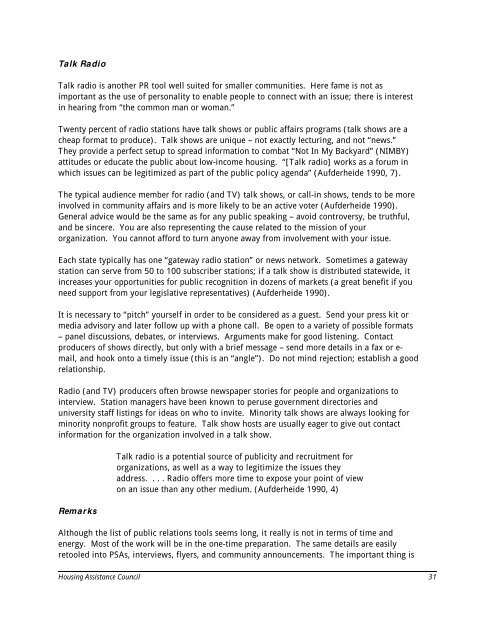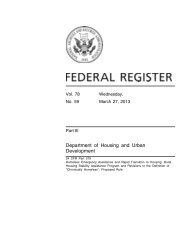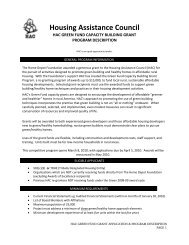Public Relations Guide for Rural Housing Organizations (manual
Public Relations Guide for Rural Housing Organizations (manual
Public Relations Guide for Rural Housing Organizations (manual
Create successful ePaper yourself
Turn your PDF publications into a flip-book with our unique Google optimized e-Paper software.
Talk RadioTalk radio is another PR tool well suited <strong>for</strong> smaller communities. Here fame is not asimportant as the use of personality to enable people to connect with an issue; there is interestin hearing from “the common man or woman.”Twenty percent of radio stations have talk shows or public affairs programs (talk shows are acheap <strong>for</strong>mat to produce). Talk shows are unique – not exactly lecturing, and not “news.”They provide a perfect setup to spread in<strong>for</strong>mation to combat “Not In My Backyard” (NIMBY)attitudes or educate the public about low-income housing. “[Talk radio] works as a <strong>for</strong>um inwhich issues can be legitimized as part of the public policy agenda” (Aufderheide 1990, 7).The typical audience member <strong>for</strong> radio (and TV) talk shows, or call-in shows, tends to be moreinvolved in community affairs and is more likely to be an active voter (Aufderheide 1990).General advice would be the same as <strong>for</strong> any public speaking – avoid controversy, be truthful,and be sincere. You are also representing the cause related to the mission of yourorganization. You cannot af<strong>for</strong>d to turn anyone away from involvement with your issue.Each state typically has one “gateway radio station” or news network. Sometimes a gatewaystation can serve from 50 to 100 subscriber stations; if a talk show is distributed statewide, itincreases your opportunities <strong>for</strong> public recognition in dozens of markets (a great benefit if youneed support from your legislative representatives) (Aufderheide 1990).It is necessary to “pitch” yourself in order to be considered as a guest. Send your press kit ormedia advisory and later follow up with a phone call. Be open to a variety of possible <strong>for</strong>mats– panel discussions, debates, or interviews. Arguments make <strong>for</strong> good listening. Contactproducers of shows directly, but only with a brief message – send more details in a fax or e-mail, and hook onto a timely issue (this is an “angle”). Do not mind rejection; establish a goodrelationship.Radio (and TV) producers often browse newspaper stories <strong>for</strong> people and organizations tointerview. Station managers have been known to peruse government directories anduniversity staff listings <strong>for</strong> ideas on who to invite. Minority talk shows are always looking <strong>for</strong>minority nonprofit groups to feature. Talk show hosts are usually eager to give out contactin<strong>for</strong>mation <strong>for</strong> the organization involved in a talk show.RemarksTalk radio is a potential source of publicity and recruitment <strong>for</strong>organizations, as well as a way to legitimize the issues theyaddress. . . . Radio offers more time to expose your point of viewon an issue than any other medium. (Aufderheide 1990, 4)Although the list of public relations tools seems long, it really is not in terms of time andenergy. Most of the work will be in the one-time preparation. The same details are easilyretooled into PSAs, interviews, flyers, and community announcements. The important thing is<strong>Housing</strong> Assistance Council 31









